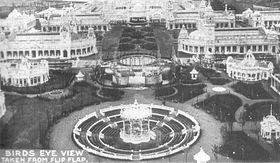Franco-British Exhibition
The Franco-British Exhibition was a major international fair held in White City , London , from May 14th to October 31st, 1908 . The aim was to consolidate the entente cordiale between the United Kingdom and France that had been agreed four years earlier .
The exhibition had over eight million visitors and was the largest that had taken place in Great Britain until then. It was also the first international trade fair jointly organized and financed by two countries. At the same time, the IV Summer Olympics took place, the newly built White City Stadium was in the eastern part of the 56 hectare exhibition area. Only fencing competitions took place on the site itself .
A total of 175 buildings were arranged in a certain symmetry; opposite a British building was usually its French counterpart. There were also gardens, parks, an artificial lake with a waterfall and band pavilions.
The exhibition grounds were easily accessible by public transport. Several railway, underground and tram lines passed right next to the exhibition center. New stations were built on both the Metropolitan Railway and Central London Railway routes , both named Wood Lane (see Wood Lane (Central Line) and Wood Lane (Metropolitan Line) ).
The exhibition showcased the British and French achievements in industry, art, science, horticulture, education and leisure.
Two so-called Völkerschauen with people from the respective colonies formed a focus . The main attraction were two so-called “colonial villages”, an “Irish” and a “Senegalese village”, which were supposed to demonstrate the success of the colonization . In the Irish village ("Ballymaclinton") lived 150 "colleens" (Irish girls) who were dedicated to various forms of local handicrafts, both technical and artistic. The "Senegalese village" was a so-called "native village" in which everyday life and various artistic products were shown. The press highlighted the "surprising cleanliness" of the Irish, and the reader learned that the Senegalese were "cleaner than they looked".
Shortly after the end of the exhibition, the buildings were torn down again, roads were laid out and the area was built over with housing developments. The White City Stadium lasted the longest, but in 1985 it had to give way to a new building by the BBC .
Web links
literature
- Alexander CT Geppert, Fleeting Cities. Imperial Expositions in Fin-de-Siècle Europe , Palgrave Macmillan, Basingstoke 2010
